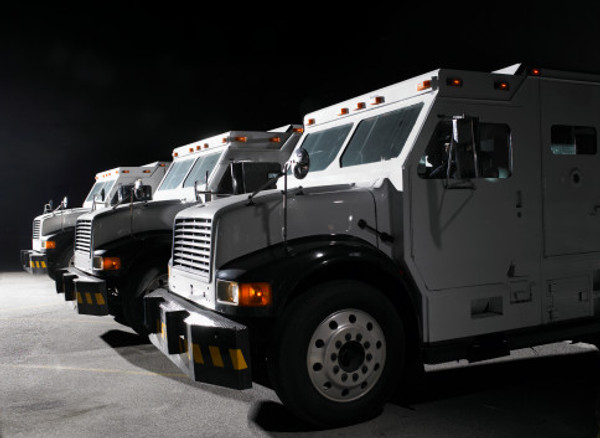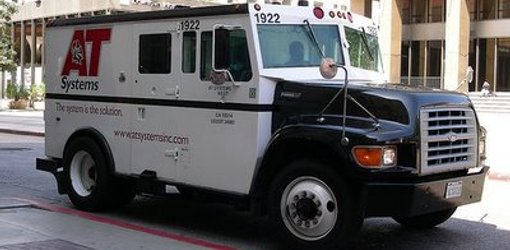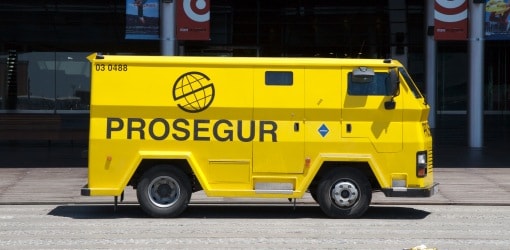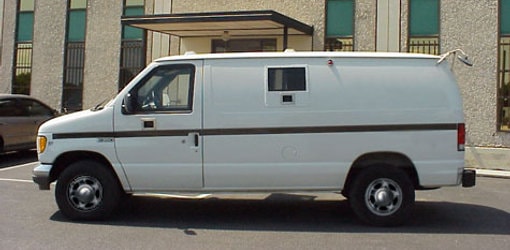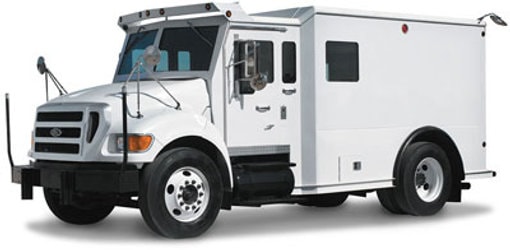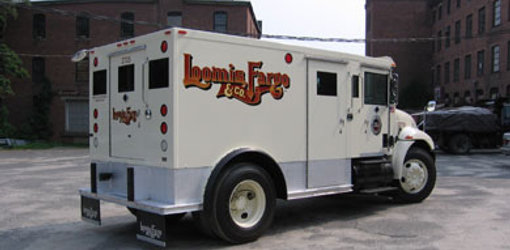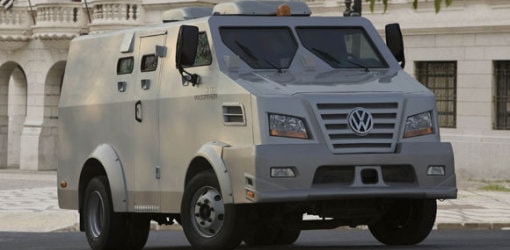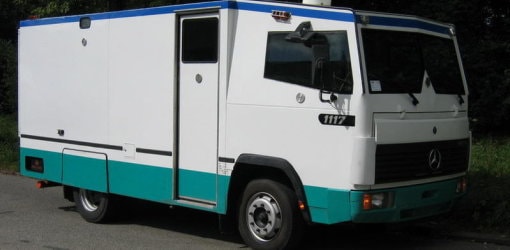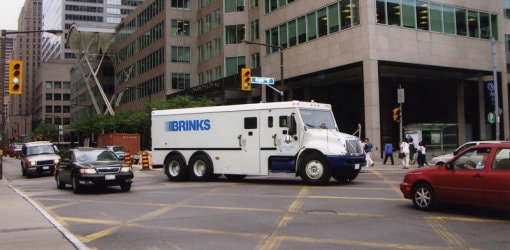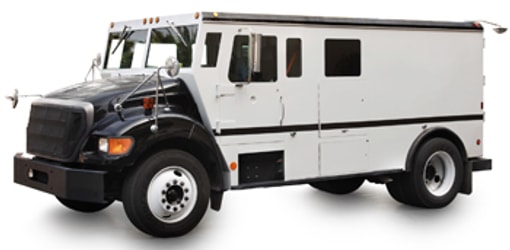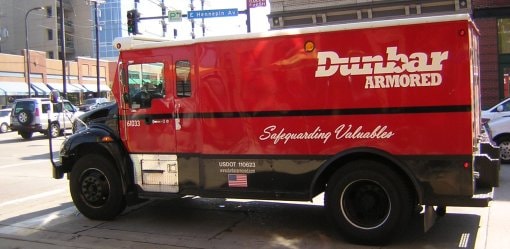One of Hollywood's favorites, the armored truck is one of those inventions which would easily fit into the "boys and toys" category. Three thrill-giving concepts meet in only one idea - armor, money and truck (not necessarily in that order).
We all see them on the streets, passing by with God knows how much money hidden in their bellies. For some, such a sight stirs a wave of adrenaline which leads to Mutulu Shakur-like behavior. For others, they only create the need to see "The Italian Job" again (ok, Charlize Theron may have a say in this one), while for the most us the sight of an armored money truck triggers a sort of childish fear: "Don't even look, they're armed and have a license to shoot"
Still, the core of the money transport remains the truck. As we said, we all saw them, but not all know who makes them. Do they come ready-armored, or are they just only plated series vehicles?
As you might have guessed, the concept of transporting valuables and money in armored trucks is relatively new. Not because in the past robbers were a rara avis, but because the technology to turn the concept into reality did not exist.
Money and valuable transport began with humans as means of transportation. Since armor was out of the question, the couriers, whether they were traveling by foot, horse or coach had to be fast and cunning. Of course, their rate of success wasn't so good, as robbers were slower, less bright but often came in greater numbers.
In mid-20th century, the concept of the armored valuable transport vehicle was born, largely due to the large use of armored vehicles in the two world wars. In the 1920s and 1930s, the increase in violent robberies forced the armored truck into existence.
In the 1920, fearing robbery attempts, a Chicago based delivery company called Brinks began fitting steel plates on the lower body panels of the buses they used for transport. It was the beginning of a self-sustaining industry, now called "cash-in-transit," (CIT) which makes use of a wide range of vehicles and "take your mind off robbing me" technologies.
As you might have guessed, early armored transports were only converted vehicles, based on series production. Aside from being fitted with armored plating (usually steel), no other major alterations were brought to them. Additionally, the armor was only placed on the sides of the vehicle, while the floor and roof remained unprotected.
It took a daring robbery to change this way of building armored trucks. In 1927, ingenious thieves planted explosives in the road and blew up a Brinks truck, getting away with some $100,000 in cash, as noted here. It marked the beginning of today's armored truck design.
Since then, not much has (nor will it change from now on) in cash-in-transit armor design. Whether it is built by a vehicle manufacturer, or retooled by an armor specialist, the trucks must follow the same principles.
Armor
The defining feature of a money/valuable transport vehicle is its armor. Today's tendency is to build the armor right into the elements which make up the car and not fit it on top of the usual body of the car. Today's armor is usually made of steel, despite the fact that in the 1940s some attempted to use aluminum, hoping for reduced weight. Of course, aluminum proved less reliable than steel. The steel used for the armor is not fitted "as is" onto the truck, but has to undergo several changes to become CIT worthy.
Unlike in the past, the vehicle's windows also have to be bulletproof. Besides making the glass out of layers of glass mixed with layers of bullet-resistant optical plastic, armored truck manufacturers also fit as few windows as possible onto the truck, to limit weak spots. The existing windows do not roll down, so the trucks obviously use air conditioning.
Appearance
Armored trucks are not meant to enter any beauty contests, so there's really no design cue to admire. They are basically cubes-on-wheel, but the design rules they have to follow can be regarded as more demanding than the ones for usual series vehicles.
Whereas the body needs to be as sturdy as possible and its shape and positioning is of little consequence to the strength overall of the armor, the windscreen, the Achilles' heel of the armor truck, needs special attention. Conventionally, the windshield is fitted at a 45 degrees angle, to help it deflect incoming bullets and lower wind resistance at the same time.
At the front, armored trucks get scary with the use of steel ram bumpers and front grill guards. The bumpers come in all shapes and sizes, but they must be powerful enough to push obstacles out of the way without endangering the lives of those inside or the security of the transport.
The Weak Link
Armored trucks are ferocious enemies when on the move. Things become tricky however when the truck comes to a halt. Armored trucks are most vulnerable when they are stationary and even more so when loading/unloading. Although the armored truck usually has a crew of two or more armed guards, human flesh comes no where near to the strength of the steel. Most modern day robberies, spearheaded by the 1981 Brinks robbery, take place when the car is stationary.
With the human element in mind, armored truck designers decided to separate the crew cab from the vault, as the back of the truck is called.
Future
No one expects armored trucks to evolve into something entirely new in the future. Their main role, to protect and transport, will remain the same as years pass. What will change are the technologies fitted into the armored trucks to help the weak link become less so. Since armed escorts no longer accompany armored trucks, the tendency will be to transform them into autonomous platforms, able of getting out of trouble on their own.
We all see them on the streets, passing by with God knows how much money hidden in their bellies. For some, such a sight stirs a wave of adrenaline which leads to Mutulu Shakur-like behavior. For others, they only create the need to see "The Italian Job" again (ok, Charlize Theron may have a say in this one), while for the most us the sight of an armored money truck triggers a sort of childish fear: "Don't even look, they're armed and have a license to shoot"
Still, the core of the money transport remains the truck. As we said, we all saw them, but not all know who makes them. Do they come ready-armored, or are they just only plated series vehicles?
As you might have guessed, the concept of transporting valuables and money in armored trucks is relatively new. Not because in the past robbers were a rara avis, but because the technology to turn the concept into reality did not exist.
Money and valuable transport began with humans as means of transportation. Since armor was out of the question, the couriers, whether they were traveling by foot, horse or coach had to be fast and cunning. Of course, their rate of success wasn't so good, as robbers were slower, less bright but often came in greater numbers.
In mid-20th century, the concept of the armored valuable transport vehicle was born, largely due to the large use of armored vehicles in the two world wars. In the 1920s and 1930s, the increase in violent robberies forced the armored truck into existence.
In the 1920, fearing robbery attempts, a Chicago based delivery company called Brinks began fitting steel plates on the lower body panels of the buses they used for transport. It was the beginning of a self-sustaining industry, now called "cash-in-transit," (CIT) which makes use of a wide range of vehicles and "take your mind off robbing me" technologies.
As you might have guessed, early armored transports were only converted vehicles, based on series production. Aside from being fitted with armored plating (usually steel), no other major alterations were brought to them. Additionally, the armor was only placed on the sides of the vehicle, while the floor and roof remained unprotected.
It took a daring robbery to change this way of building armored trucks. In 1927, ingenious thieves planted explosives in the road and blew up a Brinks truck, getting away with some $100,000 in cash, as noted here. It marked the beginning of today's armored truck design.
Since then, not much has (nor will it change from now on) in cash-in-transit armor design. Whether it is built by a vehicle manufacturer, or retooled by an armor specialist, the trucks must follow the same principles.
Armor
The defining feature of a money/valuable transport vehicle is its armor. Today's tendency is to build the armor right into the elements which make up the car and not fit it on top of the usual body of the car. Today's armor is usually made of steel, despite the fact that in the 1940s some attempted to use aluminum, hoping for reduced weight. Of course, aluminum proved less reliable than steel. The steel used for the armor is not fitted "as is" onto the truck, but has to undergo several changes to become CIT worthy.
Unlike in the past, the vehicle's windows also have to be bulletproof. Besides making the glass out of layers of glass mixed with layers of bullet-resistant optical plastic, armored truck manufacturers also fit as few windows as possible onto the truck, to limit weak spots. The existing windows do not roll down, so the trucks obviously use air conditioning.
Appearance
Armored trucks are not meant to enter any beauty contests, so there's really no design cue to admire. They are basically cubes-on-wheel, but the design rules they have to follow can be regarded as more demanding than the ones for usual series vehicles.
Whereas the body needs to be as sturdy as possible and its shape and positioning is of little consequence to the strength overall of the armor, the windscreen, the Achilles' heel of the armor truck, needs special attention. Conventionally, the windshield is fitted at a 45 degrees angle, to help it deflect incoming bullets and lower wind resistance at the same time.
At the front, armored trucks get scary with the use of steel ram bumpers and front grill guards. The bumpers come in all shapes and sizes, but they must be powerful enough to push obstacles out of the way without endangering the lives of those inside or the security of the transport.
The Weak Link
Armored trucks are ferocious enemies when on the move. Things become tricky however when the truck comes to a halt. Armored trucks are most vulnerable when they are stationary and even more so when loading/unloading. Although the armored truck usually has a crew of two or more armed guards, human flesh comes no where near to the strength of the steel. Most modern day robberies, spearheaded by the 1981 Brinks robbery, take place when the car is stationary.
With the human element in mind, armored truck designers decided to separate the crew cab from the vault, as the back of the truck is called.
Future
No one expects armored trucks to evolve into something entirely new in the future. Their main role, to protect and transport, will remain the same as years pass. What will change are the technologies fitted into the armored trucks to help the weak link become less so. Since armed escorts no longer accompany armored trucks, the tendency will be to transform them into autonomous platforms, able of getting out of trouble on their own.
